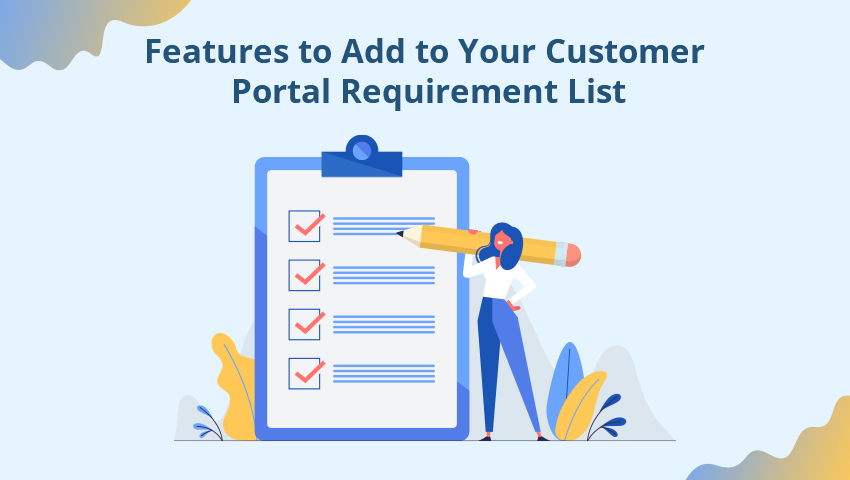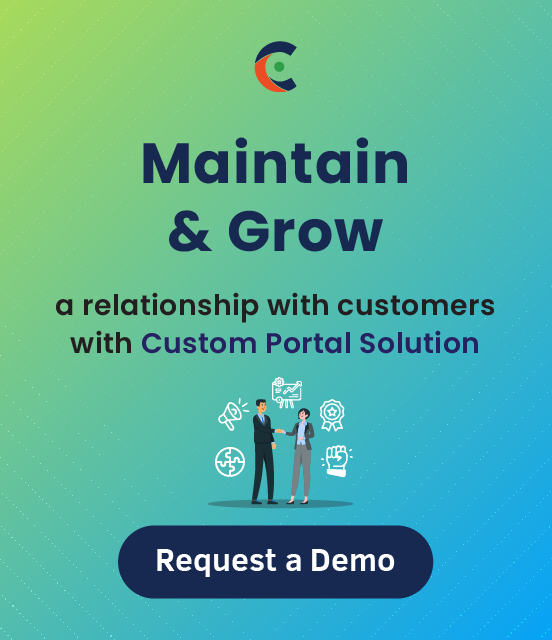Ms. Becky has a travel and hospitality business. She wanted to provide her customers with excellent service by introducing a self-service customer portal. But the results were not as expected. After analyzing, she realized that clarity on customer portal requirements is essential. But, unfortunately, she missed out on the customers’ needs and the essential features for custom portal development.
And that’s what we will talk about in this blog.
- Customer portal features
- Advanced features
Things Required for Customer Portal
You might have a customer login, but the results may be unmatched. Here’s the list of 10 customer portal requirements to meet your and your customers’ expectations.
1. One-Click Sign-In
The primary goal of a customer portal is to enhance customer service. Better service means quick access to updated information and seamless interaction with the business. So, having an online login option is not enough. You need to make sure that the customers can log in easily without wasting too much time. For instance, if it’s a new user, they don’t have to go through the entire registration form filling in the birth date, age, category, and other details manually.
It should be smooth and instant. Hence, add a social login feature to allow customers to register and login in via their Facebook or Google accounts. Also, integrate effective user management so that customers can upload and maintain their user account.
2. Easy Navigation
A customer portal should be unambiguous to use. For instance, students using an education portal should find courses and information they require quickly. If they had to contact the support team to view their attendance or the latest news, that’s cumbersome. Instead, they should find the latest events and data easily.
And so, the UI of the portal should be intuitive and clutter-free. It should lead users to the help they may need without requiring a manual on how to navigate. While designing UI, think about how you can make it easy for customers. Take inspiration from social media like Facebook, Instagram, and LinkedIn. Users don’t need a manual to use those portals or search for the latest events.
3. Responsive Layout
Having a responsive customer portal means customers can access it from laptops during office hours or on a mobile phone at midnight.
You can’t predict how they will use the service. Most of them might prefer accessing the portal via mobile phones. And if you limit them to take appropriate actions through the computer, you lose their trust.
So, ensure that it’s responsive and the style is consistent.
4. Knowledge Base
Self-service is important for the generation that grew up in the digital era. They have high expectations of brands whether they are looking for information or a solution. Hence, you must provide them with excellent service with minimal human interactions. You need to give them clear instructions on using the portal, product/service, easy-to-handle user manuals, exhaustive collection of FAQs in a modern way.
As the content becomes the first step in the buying and solving process, it’s essential that you provide them with a searchable knowledge base. It should consist of documentation, FAQs, blogs and videos, news, manuals, user guides, and other types of content. You can use a user manual software to create user guide documentations.
5. Ticket Submission
Raising tickets is how customers interact with the support team when they couldn’t solve the query themselves or find sufficient data in a knowledge base or online community forum.
With this customer portal feature, customers can:
- submit the tickets
- read the ticket history
- see the status
- track the ticket progress
Depending on the services you provide, customers may or may not be required to log in to raise a ticket. But, this feature should be included in customer portal requirements.
6. Customer Forum
Forums help businesses to build online communities where customers can interact and help one another by answering questions and sharing best practices. It can save your support team a lot of time. Customers can get help from the online community or other users facing similar issues.
Not only this, this community can work as your support team. It can open ideas for your business. You can learn what your customer thinks about your product and services or what more they expect.
7. Search Option
Placing a search icon on a customer portal helps customers find relevant information. They can quickly look for knowledge base articles, forums, and suggestion boards. It helps them find answers quickly without wasting time searching manually.
While adding the search option, ensure that the suggestions regarding the inquiry displays in real-time. So that the visitors can click on the relevant content and find appropriate content, if possible, add multiple search options that allow users to search in specific categories only.
These are the basic customer portal features to add to your customer portal requirements.
Other features include:
- Case deflection
- Proposal generation
- Interactive dashboard
- Product catalog
- Real-time notifications
- Integrated calendar
8. Chatbot Integration
A chatbot offers instant responses to customer queries, helping users with common questions, navigation issues, and even actions like appointment scheduling. This customer portal feature reduces the workload on your support team while ensuring customers receive immediate assistance.
9. Multi-Language Support
If your business operates globally, multi-language capabilities are a must-have. This customer portal feature ensures customers can use the portal in their preferred language, enhancing accessibility and creating a more inclusive experience. Supporting multiple languages not only improves user satisfaction but also reflects a commitment to serving a diverse audience.
10. Two-factor authentication (2FA)
Security is critical, especially for portals handling sensitive customer data. Adding 2FA enhances account security by requiring an additional verification step during login. This customer portal feature reassures users that their personal and financial information is well-protected.
How CRMJetty Can Help You
CRMJetty has a decade of experience developing portals for various businesses. We know about the requirements that businesses have while developing a custom portal. Learning from that curve, here’s how we can help you:
Communication
Every business is unique. To ensure that, we engage with you to know all your requirements and what we can provide. Our team will keep you in the loop by sharing iterative updates. That means you will always know what’s going around and what you can expect. You can even ask for changes in the functionality during the development phase.
Customization
We know that readily available features are not always enough. Sometimes the customization is necessary. Hence, we provide a custom portal development too. Our development team will gather your requirements, analyze them, plan a roadmap, discuss it with you, and start developing. You can ask for any customization for a new to be developed portal or the existing one, even if it’s just a feature.
Take a look at our client US Housing Consultants’ case study. See how we customized the portal to meet their requirements.
Security
Security is paramount, especially if it’s related to customers. Hence, while developing, we undergo rigorous testing to ensure there are no loopholes and the system is secure. Besides, you can add our customer portal as an extension to your CRM or individual to keep the database on your server and retain security.
Workspace
We know how much branding matters, and so we provide white label solutions. You can ensure that your logo and brand stay at the front without any hidden watermark that says third-party tool.
There’s a lot more we can offer you. Such as advanced customer portal features explained below.
Advanced Features CRMJetty Customer Portal Offers
We know that to get the best results, we need to provide the best. So, here’s what we offer in addition to the above customer portal requirements list.
1. Option Suggestion
If your business is apparel or footwear, you can learn from their history about their likes and finetune their shopping the next time they purchase something. Based on their past purchases, a portal can even suggest a size – fit for them. This helps you understand your customers and make your products and services fit for them.
2. Data Visualization
Customer interaction helps you learn a lot about your customers. With a portal, you can gather a lot of data and study. Such as identifying how many people raised similar queries, the number of people looking for the same product – can give you an insight into your business.
3. Role-based Access
Just like in CRM, the users will have limited access to the portal based on their roles. It means the admin can govern who can access a specific data or module. If you don’t want customers to edit their invoices, well, they won’t.
4. Feedback
Encourage customers to share feedback about your products and services. Small feedback can help you make better improvements.
This was just an overview of the features. If you require, we can help you with other custom customer portal features like live chat, cross-selling, query reports, virtual assistant, and more.
The development includes requirement gathering, iteration, development, QA and testing, and maintenance.
All product and company names are trademarks™, registered® or copyright© trademarks of their respective holders. Use of them does not imply any affiliation with or endorsement by them.







